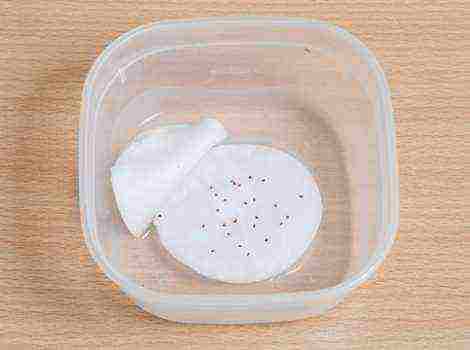Content
- 1 Can watermelons be grown in a greenhouse all year round?
- 2 Benefits of using a greenhouse
- 3 How to choose and prepare a greenhouse or greenhouse?
- 4 Selection of varieties and purchase of seeds
- 5 Planting and caring for a crop with your own hands
- 6 Possibility of joint planting of watermelons with melons and tomatoes
- 7 Harvesting
- 8 How to start growing watermelons in a greenhouse
- 9 Training
- 10 Agrotechnics
- 11 The right greenhouse
- 12 Seeds and seedlings
- 13 How to grow a watermelon in a greenhouse (video)
- 14 Care for melons in the greenhouse
- 15 Watermelons and melons in a greenhouse (video)
- 16 Gallery: watermelons and melons in the greenhouse (15 photos)
Watermelon is considered a heat-loving plant, so many believe that growing such a crop in the northern or central regions is impossible. In fact, this sweet and huge berry can be obtained in absolutely any region, if you build a greenhouse on the garden plot and adhere to all the rules regarding plant maintenance.
Can watermelons be grown in a greenhouse all year round?
Growing watermelons in a greenhouse is aimed at getting the harvest of this crop in the central and northern regions of the country. The year-round cultivation of watermelons is unlikely to end with success, because for this crop all the prescribed planting dates must be observed. By the way, square watermelons can also be grown in a greenhouse.
The greenhouse is needed in order to correct the weather conditions and make them more suitable for the growth of such plants. In the off-season, the cultivation of watermelons even in a greenhouse is unlikely to end with success, because the berry does not have enough sunlight to fully ripen. In the event that you still manage to harvest the crop, it will no longer be so tasty and sugary.
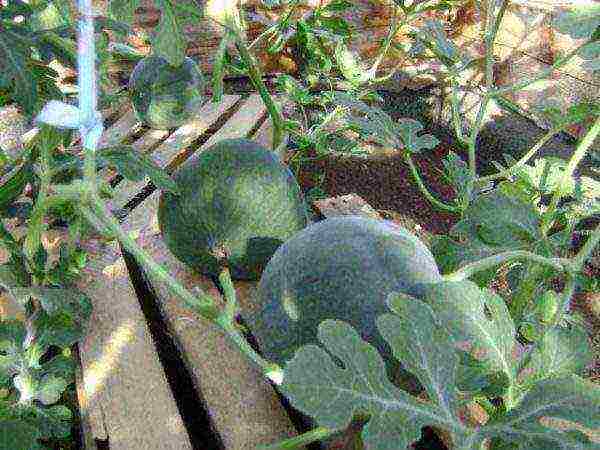 Watermelons in greenhouses
Watermelons in greenhouses
Benefits of using a greenhouse
Growing a watermelon in a greenhouse will help create the necessary climatic conditions and protect the plant from various natural disasters. In addition, the covering structure boasts the following advantages:
- Late return frosts, characteristic of the central and northern regions, negatively affect the development of culture. Using a greenhouse, you don't have to worry about this factor;
- Too much moisture in the soil and air can significantly affect the taste of the fruit, they will become less sweet and watery;
- The greenhouse will help to avoid various types of mechanical damage.
The construction of such a structure in the southern areas is not profitable, because there are favorable weather conditions and the harvest ripens without creating additional conditions there. As for other regions, the greenhouse will be an excellent way to grow such a melon crop.
How to choose and prepare a greenhouse or greenhouse?
In order to start growing watermelons in a greenhouse, you first need to build such a covering structure. The size of the land plot and the greenhouse itself will depend on the wishes of the gardener. It should be borne in mind that such plants are planted according to the scheme at a distance of 1 meter from each other, therefore, to grow 10 bushes, you need a structure with an area of 10 square meters, with a length equal to 5 meters and a width equal to 2 meters.
Watermelon, like cucumbers, is grown on trellises, so for the plant to feel comfortable and not be limited in growth, the height of the greenhouse should be at least 2 meters.
To determine which design is best suited to others, you should consider their characteristics:
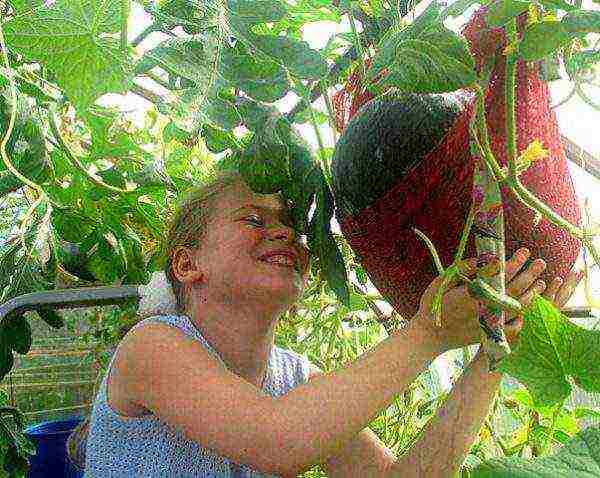 Tied watermelons in the greenhouse
Tied watermelons in the greenhouse
- A greenhouse covered with film will be the cheapest and easiest option. The downside of the design will be that it is impossible to install additional heating in it, and, accordingly, it will not be possible to control the temperature regime in the room. It is possible to plant seedlings in such a structure as early as May at home or in the country.
- The glass structure will be the most bulky you will have to establish a foundation for it. But if you build such a greenhouse, you can be sure of its durability and reliability. It is possible to build a heating system in it;
- A polycarbonate greenhouse will be the best option, the only drawback of which will be the price. The structure is easy to install, holds firmly in place and creates opportunities for organizing heating. Planting seedlings is possible in April. Growing fruits with your own hands is not difficult.
Before planting watermelons, the greenhouse is prepared for this process:
- Pipes are laid underground, through which hot water will flow and thereby create additional heating. A gas or electric boiler can be used as the main element;
- In order to be able to increase daylight hours, fluorescent lamps are installed on the roof of the structure;
- Melons and gourds do not tolerate the occurrence of fungal diseases, therefore, the frame, covering material and soil must be disinfected with Brodsky liquid or a solution of copper sulfate.
Selection of varieties and purchase of seeds
In order for a watermelon to ripen and give a good harvest, even in the northern region, it is necessary to choose the right variety, it must be zoned and refers to an early or medium ripening period. The following varieties of watermelon are popular:
- Siberian;
- Charleston near Moscow;
- Gift to the north;
- Light;
- Cinderella, etc.
Seeds suitable for growing crops must be large and heavy. Hollow planting material will not be able to adapt to environmental conditions.
You can check the quality of the seeds using a saline solution, into which the future planting material is released. For sowing, specimens that have settled to the bottom are suitable. Before planting, they are pre-washed and dried.
Planting and caring for a crop with your own hands
In order to grow a watermelon in a greenhouse, you need to take into account many factors that affect this process. In addition, they need to be looked after, watered and fed.
Growing seedlings
In order to get watermelons from seeds, you first need to grow seedlings.... It is necessary to plant seeds at the end of April. As a fertile soil, a mixture of pergnea, sod land, sand and mineral fertilizers is used.
Before sowing the seeds, they are soaked in warm water for several hours. With this procedure, you can improve their germination. To disinfect the planting material, it is immersed for several minutes in a weak solution of potassium permanganate.
Peat pots, plastic glasses or cut bottles filled with fertile soil are used as containers for growing seedlings. Seeds are sown one at a time, deepening them by 3-4 centimeters.
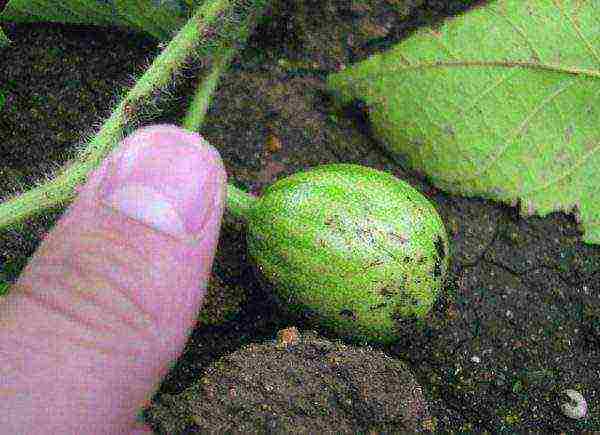 Small watermelon fruit
Small watermelon fruit
In order for the seedlings to appear as quickly as possible, the container must be kept in a room with a temperature of at least 25 degrees. With the further cultivation of seedlings, you should adhere to some rules:
- Daylight hours should be at least 14 hours a day;
- Watering the seedlings must be very careful so as not to get on the foliage of the plant;
- The pots should be spaced 20-30 centimeters apart;
- Watermelons respond well to mineral fertilizing.
Planting seedlings in a greenhouse
Before planting watermelon seedlings in greenhouses, you need to prepare the soil. This culture prefers fertile soils with neutral acidity. To achieve the best result, the following components are added for digging:
- humus;
- peat;
- superphosphate;
- potassium salt;
- ammonium sulfate.
The next step will be the formation of bulk ridges, which are placed along the walls of the greenhouse. They should be 30 centimeters high and 50-80 centimeters wide. The optimal distance between the rows is 1 meter.
Seedlings are planted according to the following algorithm:
- To begin with, dig holes 10 centimeters deep;
- The seedlings are taken out of the container along with an earthen clod. This is necessary in order to avoid damage to the root system;
- Plants are staggered at a distance of 50-70 centimeters from each other;
- Deepening the root collar into the ground can cause decay, so it is left on the surface;
- After the seedling is in the ground, it must be watered and mulched with sawdust.
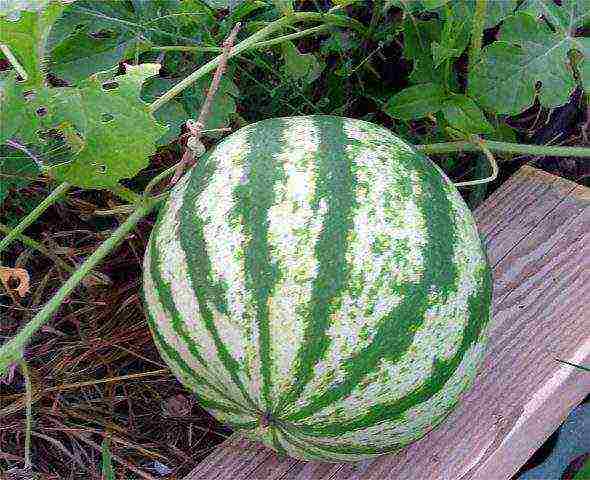 Watermelon close up
Watermelon close up
Correct temperature and lighting
In the best way, watermelon develops and forms its fruits at an air temperature of 30 degrees. To avoid condensation, the greenhouse is periodically ventilated, while avoiding the creation of a draft.
Optimal daylight hours should be 14 hours... With a lack of this indicator, it is necessary to use artificial lighting. Watermelon does not react well to open sunlight, therefore, on too hot and sultry days, the walls of the greenhouse are slightly shaded.
How often to water the berry?
Watermelons have a deep root system, thanks to which the plant can extract moisture from the deep layers of the soil. How often is watering done? You need to water the bushes only when the leaves begin to wilt slightly. In this case, the risk of waterlogging is minimized. During watering, you should avoid getting drops on the leaves and shoots of the plant.
The consequences of waterlogging are root rotting and the appearance of cracks in the fruits.
To obtain the richest harvest, once a month, the soil is watered with complex mineral fertilizers diluted in water. Also, before the start of fruit formation, the bushes were fed with ammonium nitrate every 2 weeks.
Plant formation
Getting a rich harvest directly depends on how the shrubs were formed:
 Greenhouse watermelon care
Greenhouse watermelon care
- The growth point must be pinched above the fifth sheet;
- On the two lower shoots, flowers appear later than the others, so the fruits will not have time to ripen. Such lashes are removed immediately after they appear;
- Shoots without ovaries are also removed;
- In order for the berries to develop well, the shoots are tied to a trellis. Such work is performed under the second or third sheet. As the lashes grow, they are periodically twisted;
- Lateral shoots, on which ovaries have formed, are also subject to pruning. They are cropped above the third sheet above the female flowers and above the seventh sheet above the male flowers.
5-6 fruits are left on one plant, this amount is the most optimal.
Experienced gardeners believe that watermelons should not lie on the ground during fruit ripening, so they are placed in a separate net and hung from a trellis.
Pollination
After the yellow flowers appear, they will need to be pollinated on their own. In the open field, bees do this job, but in the greenhouse there are no such “workers”. The whole process takes place according to the following rules:
- It is very important not to miss the indicated dates, because male flowers fall off after a few hours, and female flowers will retain the ability to pollinate for only 3 days;
- Male flowers (the largest and without ovary) carefully pick and remove the petals so as not to damage the pollen;
- The stamens are applied several times to the pistils.
Possibility of joint planting of watermelons with melons and tomatoes
Growing watermelons in a greenhouse is quite an interesting process, and with the proper skill, such a culture can be placed in the same room with other plants:
- In order not to wait for a favorable time for planting watermelons, early greens or radishes can be grown in the greenhouse, which will be useful predecessors;
- Watermelon is a drought-resistant crop, next to which tomatoes and eggplants are successfully grown. These plants have similar care needs and rules.
- Melons are also good neighbors for watermelons. By the way, they can be planted even in the same garden bed.
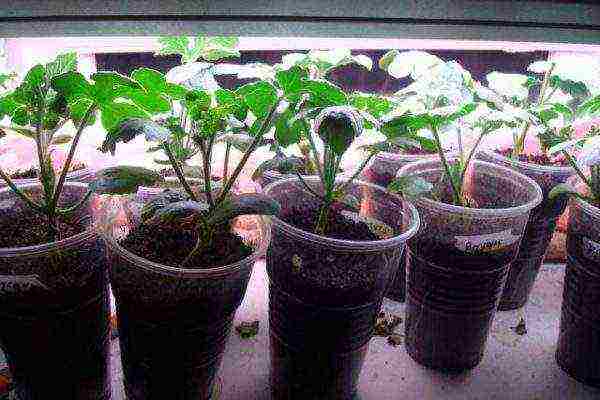 Watermelon seedlings for planting in a greenhouse
Watermelon seedlings for planting in a greenhouse
Harvesting
Harvesting usually begins in mid to late August. The full ripeness of the fruit can be judged by the following features:
- the junction of the berry and the whip partially dries up;
- a bright pattern appears on the surface of the watermelon;
- when tapping, you can hear a dull sound and feel vibration.
Gather the grown fruits very carefully to avoid mechanical damage. In the event that a scratch appears on the watermelon, the shelf life will be much shorter.
Growing watermelons in a greenhouse is a very painstaking process that requires constant monitoring of various indicators. With the help of such a design, it is possible to grow melons and gourds not only in the south, but also in the north and in other regions.

Foreword
Many people like to feast on the juicy pulp of a watermelon. This plant of the melons family did not leave anyone indifferent. And that is why many gardeners with enviable constancy try to grow a large "berry" in their personal plots and, it should be said, many have succeeded in this.
How to start growing watermelons in a greenhouse
The key to success in growing watermelons is the correct selection of seeds and their germination, appropriate cultivation and timely harvest. Seeds in this context play such a big role that the slightest mistake and the natural result will be either a weak plant with small and savory fruits, or not a blooming whip at all. Therefore, experienced gardeners recommend doing one of the following options: either purchase seeds suitable for the climatic conditions of the germination region from a reliable company, or use the seeds of a gardener who already has positive experience in growing melons in his garden. You should not use seeds obtained from unreliable sources, including those taken from berries purchased at the market or in the store. As a rule, if you do this, then you should not count on a good harvest. Of the varieties that have proven themselves well in our latitudes, it is worth paying due attention to such as:
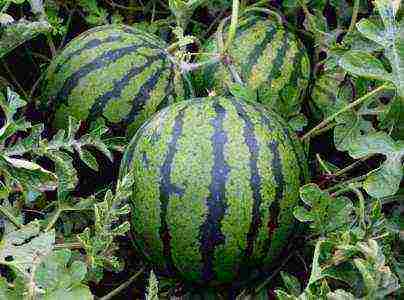
- Pannonia (early maturing variety), characterized by high resistance to low temperatures, diseases and other unfavorable conditions. The fruits are large enough - 3-5 kg. This variety is worth recommending to beginners in the cultivation of melons, as it forgives many cultivation mistakes;
- Chrisby F1. The hybrid resistant to fusarium is distinguished by its rapid fruiting, however, it is quite picky about growing conditions, although it is able to withstand a drop in temperature without harm to the fruit. The berries have a thin skin and are high in sugar in their bright red flesh. Fruit weight ranges from 5 to 7 kg;
- Suga Baby. An excellent variety for middle latitudes, it differs not only in early maturity, but also in high resistance to both pests, diseases, and low temperatures for melons. Despite the fact that the fruits are relatively small (about 4 kg)
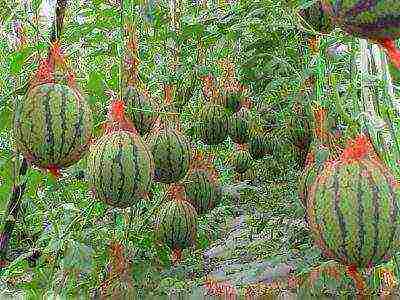
Training
In theory, a watermelon seed can be planted in the ground immediately and it will produce normal and healthy shoots. However, this applies only to the southern regions, while in the middle latitudes, planting seeds directly into the ground will lead to their death, or inhibited development. Therefore, the best way would be to work with seedlings that are easy to germinate at home.

To germinate seeds, you will need to make a container, for which a small plastic container, sawdust, vermicompost and a plastic bag are suitable. There is no need for pre-treatment of the seeds - they can be germinated immediately. The algorithm is as follows:
- at 10-20 days of April, a layer of sawdust with a thickness of 5-7 mm is poured into the jars, slightly soaked;
- seeds are placed in jars (1 per container), sprinkled with sawdust;
- the container is placed in a plastic bag, which is placed in a warm place. The most optimal for germination will be a constant temperature of up to +30 degrees Celsius, but not lower than +25, otherwise the intensity of the emergence of sprouts will be low, and when the temperature drops to + 10 ... + 15, there is a risk of seed death;

- when the first shoots appear, the sprouts are sprinkled with humus of the biotype to a height of no more than 5 mm, but not less than 3. If necessary, additional soaking can be made, after which the micro-greenhouse obtained from the container and package is placed in a sunny and warm place with a stable temperature within + 25 ... + 30 degrees;
- moving plants into the ground before planting in the ground is extremely important for the formation of a powerful root system: with stable growth signs, on the 14-17th day from the moment of germination, the plant is transplanted into a pot where there is loose soil. The soil is not compacted, it is only poured as it is compacted and caked. It is worth remembering that the soil must be loose, with a sufficient amount of nutrients. Additionally, it is worth adding sawdust and Agrovit-kor, or other vermicompost to it. Transplanting into the ground implies a gradual decrease in temperature to an acceptable + 20 ... + 25 degrees Celsius in the daytime and +18 at night.
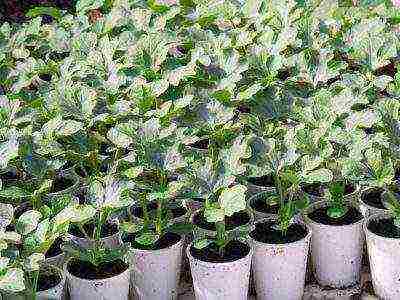
The period allocated for germination is about 20-30 days, so if warm weather is not expected in the last decade of May, germination should be continued, but overexposure should not exceed a week. In principle, preparation for germination of zucchini or cucumber seeds is an excellent guideline for starting seed germination. It is also worth paying attention to lighting - supplementary lighting is carried out to ensure rapid and confident development, therefore the total "daylight hours" should be 12 hours a day. As for watering the sprouts, it is carried out only with warm water as the soil dries up. In connection with the intensive development of the root system, special feeding is not necessary, however, when the first four leaves are set, alternate application of Planta and Kemir is introduced, alternating them with each other for weeks.
Agrotechnics
Watermelon is planted in late May and early June. The plant is immediately placed in a greenhouse, where the hole for it is additionally enriched with conventional biofuel. A frame is erected around the planted plant, on which a film or acrylic shelter is hung. The fact is that growing watermelons under a film or other covering material, even inside a greenhouse, allows you to achieve an excellent harvest in a not very hot summer. The frame should be erected so that, firstly, it can be opened and closed as needed, and secondly, so that it does not hinder the growth of plants and the appearance of fruits throughout the summer if it turns out to be not hot.
Since all melons have a special demand for heat, the soil should be prepared in advance. As a rule, a tall bed with a high concentration of manure mixed with sawdust, leaves and straw is arranged in a greenhouse. Lime can be added if necessary. However, do not increase the concentration too much, because instead of heating the soil, you can achieve "burning out" of the root system of watermelons. The beds should be wrapped in foil, cutting holes at the planting sites for stem removal.

Planting tactics in mid-latitudes implies a five-point placement of plants, where there are up to 5 plantings for every square meter of land.
The soil should be neutral, preferably well aerated and cultivated. Although watermelon is not picky about soil fertility, a good harvest can be obtained only on it, and it is not so much about the quantity and volume of fruits, but about their taste. With poor soil fertility, you cannot expect sweet and juicy berries.How to grow a watermelon in a greenhouse with low soil fertility? It is enough just to dig the soil to a depth of two shovel bayonets before planting with an additive from a mixture of lime, ash and humus.
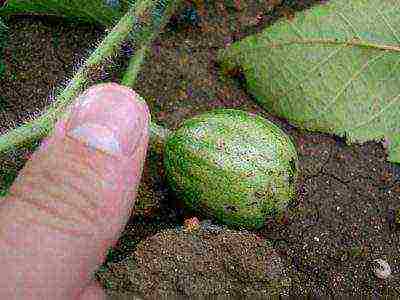
It is necessary to water the plant infrequently, contrary to popular belief. The fact is that melons in general and watermelon in particular are drought-resistant plants, since their homeland is the southern regions, where drought is considered common. Watering is done every 1-1.5 weeks, but only with warm water and in a small amount (about 2 liters per plant). Watering stops completely with the appearance of the first fruits and their beginning of ripening. At the same time, watering must be done carefully so that water does not get on the ground part of the stem, as this can lead to the appearance of root rot. After watering, the soil must be loosened. After watering, the greenhouse should be well ventilated to avoid condensation, which is harmful to melons. Correctly organized ventilation of the greenhouse and covering the beds with a film or covering material will allow you to abandon forced ventilation.
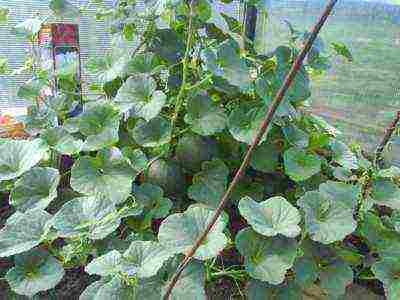
The technology of growing watermelons in a greenhouse involves fractional feeding, but not more often than once a week, with weak solutions of potassium sulfate, ash and common pumpkin dressings, for example, "Giant vegetable". The alternation of dressings for weeks is strictly necessary, since this is the only way to ensure a high concentration of sugar and ascorbic acid in berries. The weekly spraying with drugs to increase resistance to diseases and pests, for example, "New Ideal", has a positive effect.
Since watermelons are extremely sensitive to cold, in case of bad weather, it may be necessary to use a heating medium, which is extremely important at night. The easiest way to make heat accumulators is to take dark-colored PET bottles and fill them with water. The water can be tinted with ink or gouache to increase the heating rate. Heating up during the day under the influence of sunlight, the bottles will give off heat in the evening and at night, thereby maintaining the temperature regime of the greenhouse. It is best to place heat accumulators in furrows or even under greenhouses between plantings. You can also place a dark colored barrel filled with water.
Pollination of watermelons, due to their presence in greenhouse conditions, is quite difficult in a natural way. Therefore, experienced gardeners either produce it on their own, or by various tricks they lure bees into the greenhouse (for example, they place saucers with molasses near the vents).
But it is most reliable to pollinate on your own, however, it is worth remembering that, firstly, male flowers appear earlier than female flowers, secondly, the peak occurs late in the morning (10-11 hours), and thirdly, male flowers, which spend most of their time in the shade are mostly sterile.
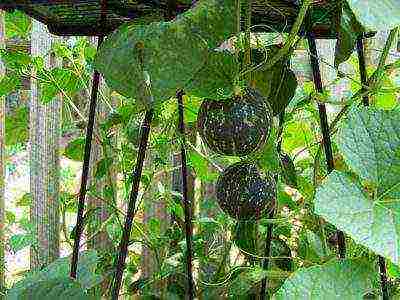
To improve the quality of the crop, it is worth strengthening the feeding with potassium, magnesium and boron, since their presence increases the sugar content of the berries.
But the presence of nitrogen negatively affects the taste, which excludes the use of popular nitrogen fertilizers. An excess of moisture, which watermelons cannot tolerate, also has a bad effect on the taste of melons. Watering at the time of fruiting is completely excluded. The technology of growing watermelons under a film requires a high degree of illumination of each lash, therefore, even during planting, pay attention to the sparseness of the plants, and as they grow, without mercy, remove weak lashes to increase the insolation of neighboring plants.
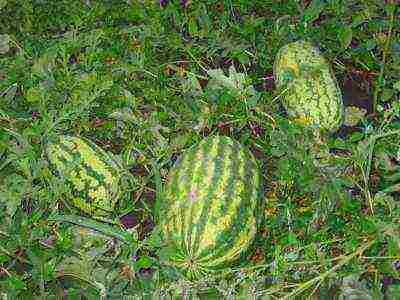
When the first signs of drying appear on the stalk, it's time to harvest. With careful handling of each berry, it can be stored for up to six months in darkened rooms at a constant temperature (for example, in a cellar or in a basement). The fruit is placed in an ash box or hung in a net without touching other berries.Watermelon care and cultivation requires a lot, but by the second or third year of experiments you will find the most optimal simple way of agricultural technology, which will provide you with an abundance of fruits with minimal labor costs.
Rate the article:
(1 vote, average: 5 out of 5)
Table of contents:
- Where is the best place to plant a watermelon
- Growing seedlings
- Choosing the right type of watermelon
- Features of growing watermelon in a greenhouse
Everyone's favorite berry, watermelon, can be grown without much hassle only in the southern regions. But every summer resident wants to grow them on his site. And if this desire is great, then he will be able to master this difficult task. There is especially a lot of trouble with watermelons in central Russia, in the Far East and in the northern regions.
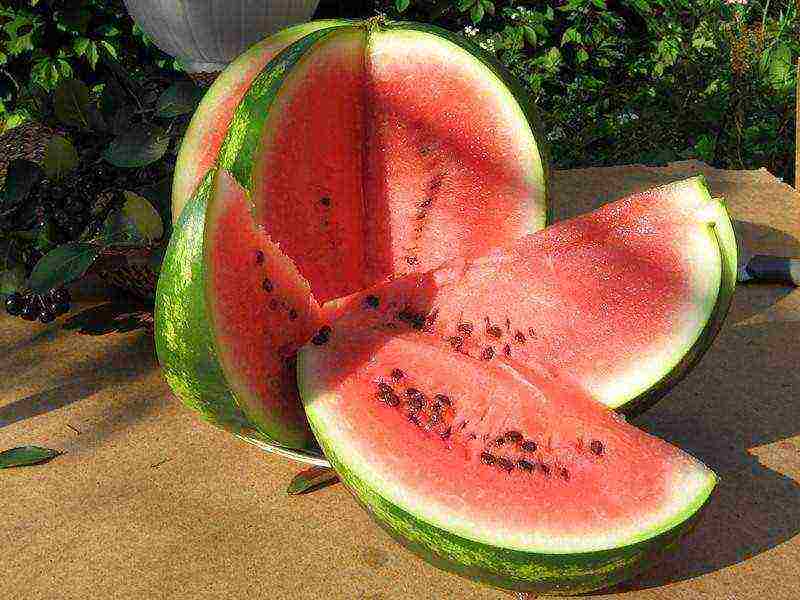
In order for a watermelon to grow and be sweet and juicy at the same time, it is necessary to provide a warm climate, good sunlight and low humidity.
Where is the best place to plant a watermelon
Watermelon is a very warm and light-loving plant. This southerner will require careful reconciliation of his landing site. Melons are not afraid of the sun, so the place for them should be open and not shaded by anything. They develop best at a stable temperature of 25 degrees. If the climate permits, seedlings can be planted in open ground. But in most cases it is better not to take risks and grow a watermelon in a greenhouse. Moreover, you need to take into account that this plant requires a lot of sun. Therefore, the walls of the greenhouse must be made of a material with a high degree of transparency. If the film is polypropylene and has a yellowish tint, then on hot days the greenhouse must be opened, otherwise the plants may burn out. However, watermelons are significantly more resistant to overheating than cucumbers. Under a closed film, they can withstand up to three days.

Sowing watermelons in the place where watermelons already grew last year is not recommended.
Experts say that it is advisable to fertilize the land for melons in the fall: to add manure and cut grass to it. It is especially important that the soil is light, loose and not acidic. It is highly recommended to add sand at the rate of 1 bucket per 1 m2. It is not advisable to plant seedlings in the same place where watermelons were grown last year. The soil must rest from this berry for at least one season. To avoid unnecessary labor costs, for melons, you can not dig up a whole strip of land, but get by with the device of holes. The diameter of each of them must be at least half a meter. The same distance is maintained between them. If it is decided to make the beds, then they must have a width of at least one meter. On the south side, you need to provide a place for whips, and leave a free strip about a meter wide. It is more optimal to plant seedlings and form holes in a checkerboard pattern.
Back to the table of contents
Growing seedlings
In all regions of Russia, except for the southern ones, watermelons must be grown through seedlings.
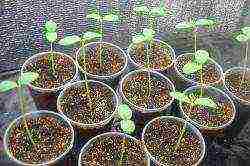
Plant sprouted seeds in a pot to a depth of no more than 4 cm and wait for germination.
The seeds are pre-soaked, like the seeds of cucumbers. And immediately before soaking itself, they need to be held for 10 minutes in hot water, the temperature of which should not exceed 50 degrees. The sprouts hatch pretty quickly: in 2-3 days. When growing seedlings, it should be borne in mind that watermelons are extremely sensitive to transplanting. Therefore, in order to avoid the death of the plant due to damage to the root system, the hatched seeds are planted only in peat pots. Their diameter should be at least 10 cm. It is necessary to inspect the soaked seeds daily to see if the sprouts have hatched. As soon as this happens, you need to immediately plant them in pots to a depth of 3-4 cm.
If the climate of the region is rather harsh, then simply waiting for the seeds to germinate will not be enough. They need to create a comfortable environment, that is, the pot should be in a warm place.The best option would be to create such conditions when, during seed germination, the ambient temperature will be 23 degrees during the day and 18 degrees at night. When the first shoots appear, the daytime temperature can be reduced to the level of the nighttime, and after 4 days everything can be returned as it was. This regime is maintained until the end of May, when it will be possible to plant the pots in a greenhouse prepared in advance. When the plants grow up, you need to make sure that their leaves do not come into contact with each other, as this will slow down their growth. Therefore, the pots with seedlings are pushed apart from time to time.
Back to the table of contents
Choosing a suitable variety of watermelon 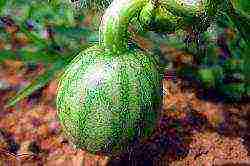
One plant should bear no more than three fruits, so if you notice that more than three small watermelons have set, remove the extra ones.
Those who want to grow a watermelon in the country often make the mistake of leaving the seeds of the berries they like eaten for the seedlings.Most often, these varieties are not suitable for growing in regions where there is little heat and sun. The reason for this is that watermelons are brought for sale from the southern regions, and these plants are very thermophilic. In other conditions, they will get sick, they can form lush bushes and not bloom, and if the fruits are tied, they will not ripen before the cold autumn days. Therefore, the choice of a watermelon variety for growing in the country must be taken seriously.
In the Moscow region and similar regions in terms of climate, the varieties Krisby, Krestyanin, Trophy work best. You can take these: Start, Emperor's Hat, Svyatoslav. In the Altai Territory, you can confidently grow a variety for yourself in the country. It bears excellent fruit even when planted in open ground. In the southern regions of Siberia, it is also suitable, but in its northern latitudes, this variety must be planted in a greenhouse. The Ogonyok variety grows well in Siberia and the Far East. It is a small watermelon with a thin crust. Its pulp is bright red, and the seeds are black. The zoned Siberian varieties Astrakhansky, Raspberry Sweet, Siberian Lights are unpretentious in care. All these berries are sweet and weigh up to 1.5 kg. It should be noted that for regions with a cold climate, it is best to grow early maturing varieties. For example, the Ultra-early variety takes only 80 days from the beginning of germination to a ripe fruit.
Back to the table of contents
Features of growing watermelon in a greenhouse
Watermelons in summer cottages can be grown together with tomatoes, since both crops need low air humidity. But you need to avoid the neighborhood with cucumbers and other moisture-loving plants. Before planting seedling pots in the greenhouse, you need to mark places for them. There should be no more than 3 plants per 1 m2. If the soil was fertilized with manure, you need to make sure that its pieces do not touch the pots. If at least 5 leaves have appeared on the seedlings, then it is ready for planting. A week before this, the plants need to be hardened. By taking the pots outside, we thereby provide the seedlings with the necessary ventilation during the adaptation period. After landing in the greenhouse in warm weather, you need to open the doors in it, especially if the material from which it is made is airtight.
After a while, when it becomes clear that the plants have begun, you can carry out foliar feeding with potassium humate or complex fertilizers, which include minerals. Melons have their own peculiarity: they extract water from the depths of the soil, therefore, watering they need is rather rare, but abundant. If produced frequently, the berries will be watery and tasteless. To combat the spider mite, which is very fond of greenhouses and greenhouses and is able to destroy all seedlings, you can use a decoction of tobacco with the addition of soap or colloidal sulfur. Perfectly repels and destroys Fitoverm pests. Plants can be safely sprayed with its solution every 10 days. It is important to ensure that condensation does not form in the greenhouse. This contributes to the development of diseases and pests.Therefore, the room in which the watermelons grow should be ventilated as often as possible.
When the watermelon blooms, it needs pollination. In a greenhouse, this will need to be done manually. That is, pick the male flowers and bring them to the female ones. But more often than not, you can simply open the greenhouse doors for pollination, or, weather permitting, remove the cover and let the bees do natural pollination. It is important to know that it is advisable to leave only 3-4 flowers on one plant, since it physically cannot grow more fruits than this amount. The formation of watermelons is simple: you need to remove excess ovaries on time. Fruits, as they grow, tend to come off and at the same time tear the stems of nearby berries. Therefore, upon reaching a mass of 1 kg, it is advisable to carefully lay the watermelons in the net and tie it to the trellis. This will ensure the safety of the crop.
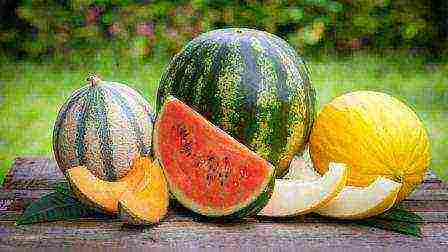 Watermelon and melon grown on their own backyard is the dream of many gardeners. As you know, these are thermophilic crops, and in more severe climates, they are best grown in greenhouses. With the right approach, this is not such a hard business, but you can eat honey melons or juicy watermelon already at the beginning of summer.
Watermelon and melon grown on their own backyard is the dream of many gardeners. As you know, these are thermophilic crops, and in more severe climates, they are best grown in greenhouses. With the right approach, this is not such a hard business, but you can eat honey melons or juicy watermelon already at the beginning of summer.
The right greenhouse
The cultivation of melons requires the creation of appropriate conditions for the plants. They need reliable protection against damage by late frosts, feeding several times per season and forming plants to obtain high-quality fruits.
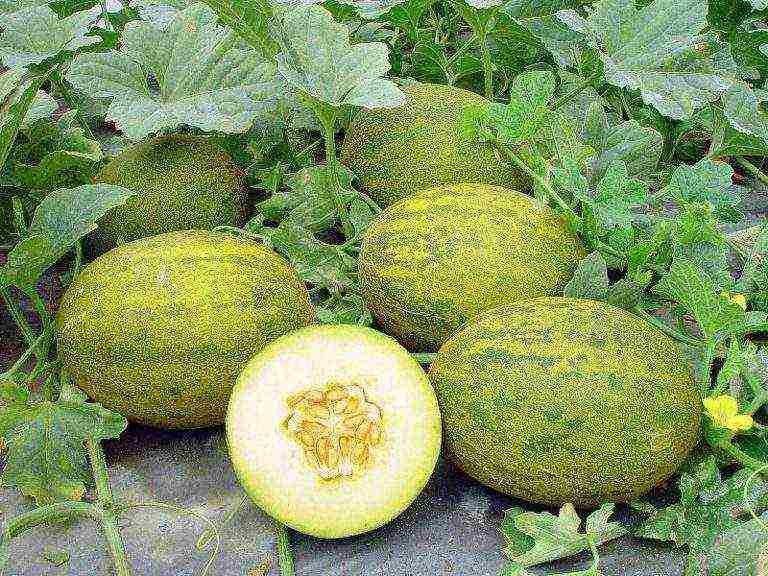
To ensure the correct development of watermelons and melons in the greenhouse, it must meet certain requirements.
- Greenhouses are not suitable for growing melons - they are too low and small. A tall greenhouse is a good option. Under natural conditions, the shoots of the plant spread along the ground, and in the greenhouse, due to the limited area, they twist along the trellises. Therefore, the higher the greenhouse is, the better. The optimal height will be about 2 m or more.
- In a greenhouse, watermelons and melons can coexist with other crops, but this is not the best option. Southern plants perfectly tolerate drought, high temperatures, but humidity in the greenhouse from 60% or more can cause fungal diseases of melons. Therefore, it is better to allocate a separate greenhouse for their cultivation.
- Melon or watermelon require neutral soil, pH 6.8-7, fertile, not very oily and well-drained. The soil should be well warmed up.
Seeds and seedlings
By choosing the right seeds, you can ensure a good harvest of greenhouse melons. When choosing seeds, it is imperative to give preference to varieties adapted to growing in a particular climate. You also need to pay attention to the ripening time: if the period from germination to ripening is short, then the fruits will be tasty and juicy. With a long ripening period, you can be left without a long-awaited harvest.
The size of the fruit also plays an important role. The best varieties for growing in greenhouses will be varieties with small fruits, giant watermelon and melon can only grow naturally in the south.
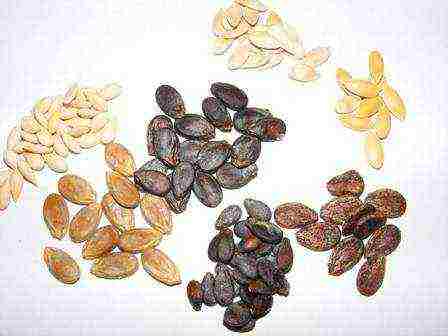
To get strong, healthy seedlings, seeds are sown in the second half of April. There are several rules that will ensure good results:
- for each plant, it is better to immediately select a separate pot or glass, with a diameter of 8-10 cm;
- to increase the germination of seeds, before sowing, they must be soaked for several hours in any immunostimulant or just in warm water (25 degrees);
- to provide the seedlings with all the necessary nutrients, three parts of humus, a glass of ash and a teaspoon of potassium sulfate are taken for one part of simple land;
- the seeds need to be immersed to a depth of 2-3 cm, and to make it easier for the sprouts to germinate, they are placed on their side;
- the temperature regime is very important, before germination, the temperature should be maintained at about 25 degrees, and after the sprouts appear, it is reduced by 3-4 degrees;
- before the emergence of shoots, the cups must be covered with foil or glass.
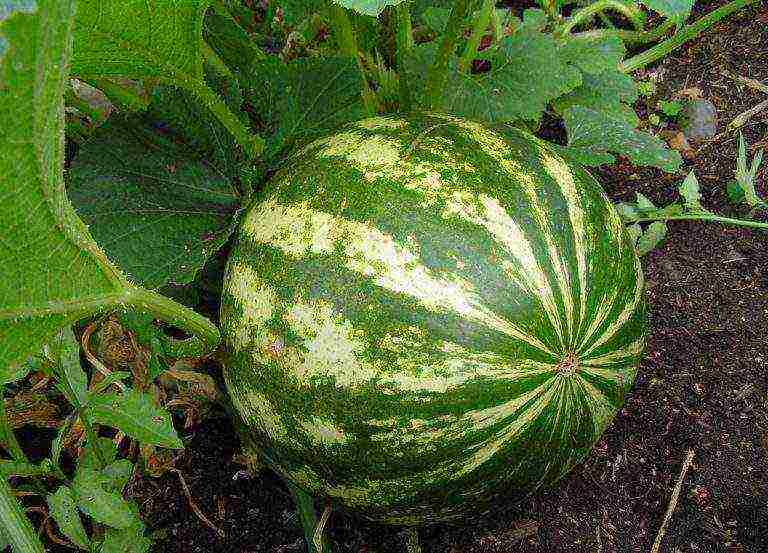
The seedlings grow very quickly. About a month after germination, it can be planted in a greenhouse. But before that, it is worth paying attention to young plants:
- as the leaves grow, you need to move the cups with melons or watermelons away from each other, giving the plants more space;
- daylight hours should be 13-14 hours, so you will have to use additional lighting lamps to prevent the sprouts from stretching and weakening;
- you need to feed the plants with a solution of complex fertilizers, the procedure is carried out 10 days after germination, and then again after 10 days.
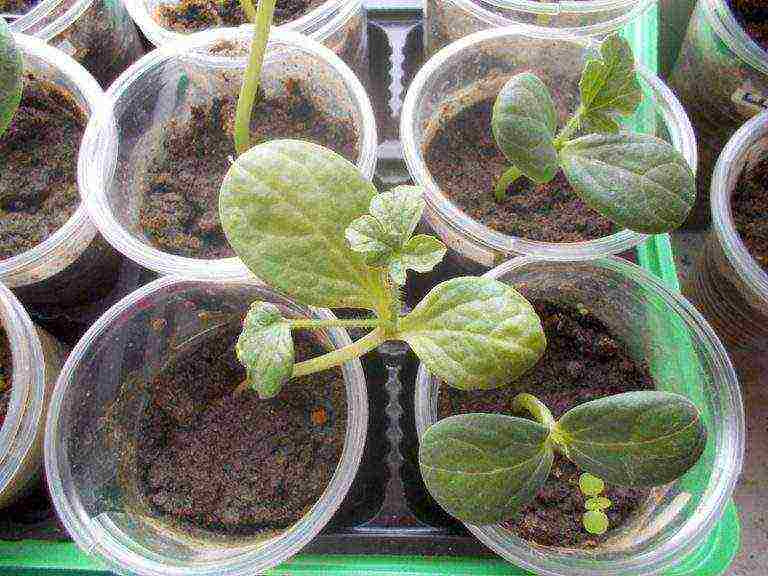
How to grow a watermelon in a greenhouse (video)
Care for melons in the greenhouse
It is possible to plant watermelons and melons in the greenhouse already from mid-May, after warm weather sets in and the night temperature does not drop below +5 degrees.
Before planting seedlings, you need to prepare the soil. In the greenhouse, they dig a trench 20 cm deep, at the bottom of which hay and humus are laid. Then nitrogen fertilizer is scattered and poured over with hot water. After that, the soil is covered and the prepared area is covered for several days with black film to quickly warm up the earth.
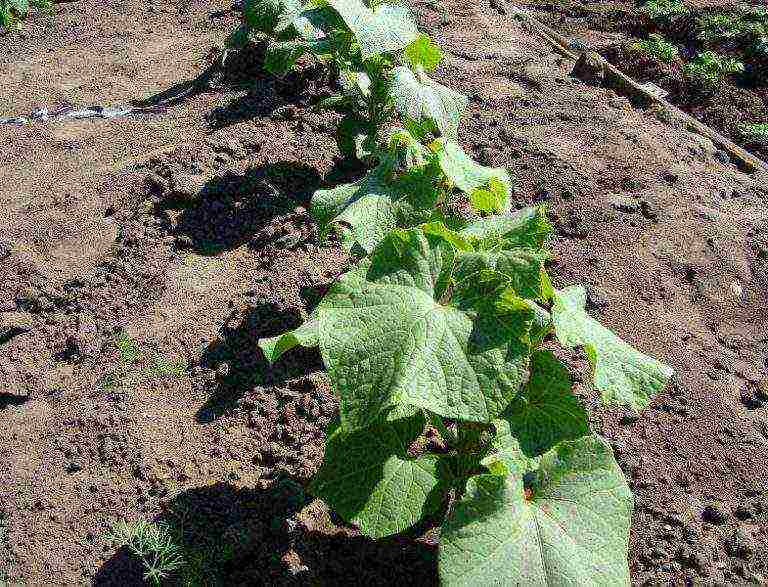
Landing is performed as follows:
- the distance between rows should be 70 cm, and between plants in a row - 50 cm;
- two plants can be planted in one hole at once, and then their shoots can be spread along the trellis in different directions;
- the holes are filled with humus and watered with plenty of warm water;
- seedlings have delicate roots, so the transfer from cups or pots to holes must be done very carefully so as not to damage them;
- a lump of earth with seedlings should be slightly raised above the soil to avoid rotting of the hypocotal knee.
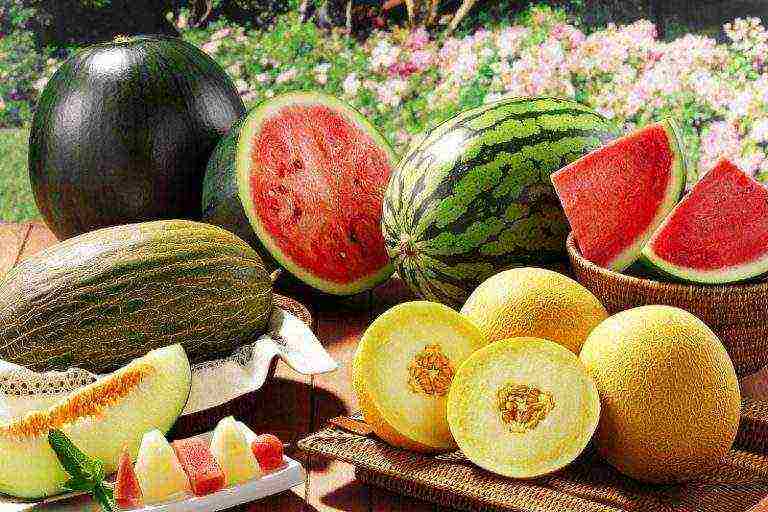
Further cultivation of watermelons and melons comes down to a few simple operations.
- Airing. If the temperature in the greenhouse exceeds 30 degrees, you need to open the vents or slightly raise the film for airing.
- Watering. If the leaves of the plants begin to drop, then this is a signal for watering. At the same time, it is necessary to avoid the ingress of water on the foliage and excessive moisture in the soil, which can lead to the development of fungus.
- Fertilization. During the period of active growth of plants during irrigation, nitrogen and ammonia fertilizers and ash are applied. When the fruits begin to ripen, feeding is stopped.
- Pollination. How to grow watermelons in a closed greenhouse without bees? You just need to do the pollination yourself. For this, large male flowers are plucked, the petals are cut off and the remaining anthers are carried along the stigmas of the female flowers.
- Pinching is performed after the appearance of 5 leaves. When the emerging ovaries reach a diameter of 4-5 cm, the strongest is chosen on each lash, and the rest are cut off.
- Plants can be tied up as early as 10 days after planting in the greenhouse. The grown fruits for tying are placed in nets and tied with twine directly to the trellis.
Adhering to the described rules, you can grow a sweet watermelon or melon even in Siberia, having received an excellent harvest.
Watermelons and melons in a greenhouse (video)
Gallery: watermelons and melons in the greenhouse (15 photos)
Rate the article:
(0 votes, average: 0 out of 5)
